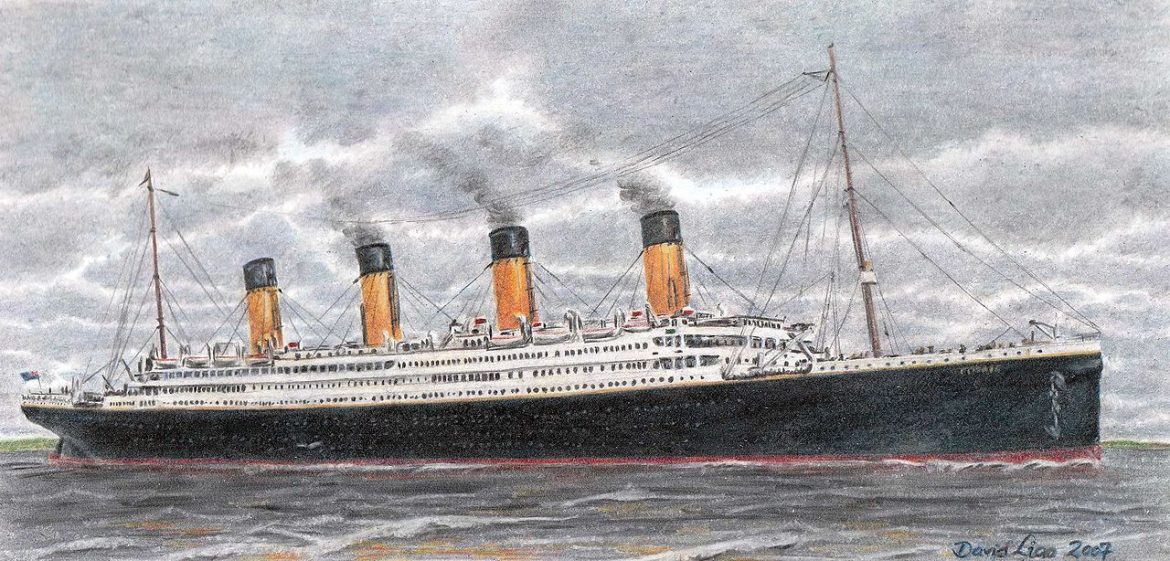March 31, 1909, marked the start of the construction of the most massive moving object ever, in Belfast, Northern Ireland. Unparalleled in technology and unsurpassed in opulence, the ship was designed to stand as tall as an 11-storey building and measure more than two football fields in length. This was a visionary and innovative endeavor by its financier, American J.P. Morgan, and builder, Harland and Wolff, who referred to it as Yard No. 401. History knows it by another name – RMS Titanic.
The ‘Ship of Dreams’ set sail on its maiden voyage from Southampton, England on April 10, 1912, counting onboard some of the most prominent people on the planet – millionaire John Jacob Astor IV, industrialist Benjamin Guggenheim, Macy’s department store owner Isidor Straus and his wife Ida – amongst its 2,223 passengers and crew. At 11:40 pm on April 14, 1912, moving at its top speed of 22 knots, the Titanic hit an iceberg off the coast of Newfoundland and sank within 2 hours and 40 minutes, taking with itself 1,517 lives. It might seem that the 37 seconds between the iceberg’s first sighting and impact were ill-fated but look more closely to notice fatal decisions that led to this devastation. Here are five glimpses into what went wrong:
1. On April 14, 1912, Titanic’s radio operators received 6 warning messages from other ships, informing them of “bergs, growlers and field ice”. Most of these messages were not relayed to Captain Edward Smith. Why? Because the primary responsibility of the radio operators, who were not crew members but employees of Marconi’s Wireless Telegraph Company, was to send messages for passengers, and weather reports were a secondary concern.
SS Californian, the ship in closest proximity to the Titanic, sent the last warning message at 11:00 pm stating that they had halted for the night because of field ice. The warning was cut off by operator Jack Phillips on Titanic, who signaled back: “Keep out! Shut up! I’m working Cape Race.”
2. With the reputation of being ‘practically unsinkable’, Titanic had too few lifeboats and lifeboat training had been minimal. The ship was designed to carry 68 lifeboats but had only 20, just enough to carry half the passengers on board.
This shortage was not due to space or cost constraints, but the owners’ desire to maintain luxurious aesthetics. Even if sufficient lifeboats were available, the crew would not have been able to launch them in time, considering they had one cursory drill and were not familiar with evacuation protocols.
3. About 40 minutes after the collision, as the lifeboats were being loaded, Second Officer Charles Lightoller yelled to Captain Smith amidst blaring sounds of escaping steam, “Hadn’t we better get the women and children into the boats, sir?”.
Captain Smith nodded yes. However, this instruction was interpreted differently by Lightoller and First Officer William Murdoch – while Murdoch took it to mean that women and children are to be placed in lifeboats first, Lightoller understood women and children only. Consequentially, most of the boats were lowered half-filled and most men were not allowed to board, including John Jacob Astor. 500 more lives could have been saved had the orders been understood correctly. 80% of the men onboard lost their lives.
4. 62-year-old Captain Edward Smith was the most senior of White Star Line’s captains and had 4 decades of seafaring experience, including 27 years in command. He was transferred from the RMS Olympic, which was Titanic’s almost identical sister ship. However, the Titanic disaster was the first crisis in Captain Smith’s career.
The crew who served under him were largely engineers, stokers, firemen, stewards, etc, with only 39 seamen and 6 watch officers. Most of them had been taken on at Southampton and had not had the time to familiarize themselves with the ship.
5. Titanic was sailing at 22 knots, only 2 short of its maximum speed when it hit the iceberg. They were aware of ice in the vicinity and were depending on lookouts in the crow’s nest to inform of any potential danger. The lookouts did not have binoculars.
The reason for the Titanic’s continued high speed in a risky area is still speculated. Many attribute it to the control and decision of J. Bruce Ismay, chairman of the White Star Line, who was onboard Titanic and had been communicated about the iceberg warnings by Captain Smith.
Titanic’s wreck was discovered on September 1, 1985, during an expedition led by Dr. Robert Ballard. The iconic shipwreck, resting 12,000 ft below the icy waters of the Atlantic Ocean, has a deep story to tell and invaluable lessons for all.
In more ways than one, the Titanic of 1912 resembles the fast-growing startups of today. Titanic was technologically the most advanced, its magnitude of operations was massive, it moved at a very high speed, and its construct was more magnificent than what the world had ever seen.
The larger-size startups today, and also intrapreneurial units of large companies, are trying to disrupt their respective industries with advanced technology, growing rapidly with the backing of investors and available funds, moving at unprecedented speed, and aligning to innovative methods of functioning.
This typically renders such organizations to have more than 100-150 employees in the growth phase. As the organization continues to grow, its operations expand, and the frequency of contact between the captain and employees reduces, and process complexities increase. This is why Titanic’s story presents the following five critical lessons and questions for CEOs, corresponding to the notes above:
1. Are your extended teams catching and relaying the right signals to the bridge? Your lower management employees or outsourced staff, usually tele teams or operations support employees, are speaking to your customers, vendors, and business partners every day and thus accumulating key market insights.
As the captain of this ship, ask yourself – are your teams catching the right signals? Are they trained enough to understand and act upon signals that can influence business priorities? Do they know what is the most pertinent information to be relayed to the bridge? Ensure they are not missing the forest for the trees.
2. Do you have sufficient lifeboats and do your people have sufficient training? Knowledge is power and in large setups, often the right-hand doesn’t know what the left hand is doing. Lifeboats would be key revenue streams and training would be needed to use all information that teams have in different pockets to leverage those boats. Ask if you have a hawk’s eye view on key metrics impacting crucial revenue streams? Are your managers utilizing the right teams and resources? Do they have visibility into each other’s areas that can impact them too? Ensure the right hand knows what the left hand is doing.
3. Are your business leaders understanding the execution orders as you intended them to? In the daily course of activities with diverse individuals leading different areas, orders can often be understood differently. Are you getting involved in execution supervision enough to know if something is amiss? If yes, are you identifying and correcting the errors in time? Ensure you’re part of the execution, not just the plan, and then manage by exception.
4. Is your team familiar with the ship? Your people can make all the difference to your business. Think about this: how many of your employees can directly make decisions for the business? How many are seamen i.e., how many are familiar with the industry or are specialists in your area of work? How acclimatized are they with the nature of your specific business? How well do they work with each other? And how prepared are you, as the captain, to face a crisis if it comes? As the captain, ensure you show-how, not know-how.
The Black Swan is inevitable, but to have an effectively working machinery, is a strong protector against such events. And you as the captain of this ship are responsible to ensure this effectiveness. As movie director James Cameron, aptly summarizes the last learning from this event:
“History has shown that every technology brings a curse with it. The lesson of Titanic is, just don’t go so fast when you’re dealing with that much power and energy, the kinetic energy of a ship that weighs 48,000 tons. Give yourself time to turn because that’s all they did wrong.”
About Author: Sanya Duggal works with Microsoft and has a decade of experience with small businesses and startups. She holds an MBA from MDI Gurgaon. She is passionate about sharing her learnings and experiences through the power of the written word. More here: Sanya Duggal | LinkedIn
References:
- Titanic by the Numbers: From Construction to Disaster to Discovery – HISTORY
- Why Did the Titanic Sink? – HISTORY
- The Titanic: Sinking & Facts – HISTORY
- Titanic: The Surprising Calm Before the Chaotic Sinking – HISTORY
- Why Titanic’s first call for help wasn’t an SOS signal (nationalgeographic.com)
- The Real Story Behind the Discovery of Titanic’s Watery Grave – HISTORY
- Interesting Titanic facts – The Washington Post
- RMS Titanic (mcgill.ca)
- Oceanus: Woods Hole Oceanographic Institution: Free Download, Borrow, and Streaming: Internet Archive
- Titanic anniversary: 20 fascinating facts about the epic blockbuster that almost sank | CBC Radio
- Titanic | History, Sinking, Rescue, Survivors, Movies, & Facts | Britannica
National Geographic Videos:
- How Did the ‘Unsinkable’ Titanic End Up at the Bottom of the Ocean? | National Geographic – YouTube
- Inside the Titanic’s FATAL Mistake | History’s Greatest Mysteries (Season 1) | History – YouTube
- Titanic’s Graveyard | Nat Geo Live – YouTube
- Save The Titanic With Bob Ballard (Full Episode) | National Geographic – YouTube
- Finding the Titanic | Bob Ballard: An Explorer’s Life – YouTube
Image credit: David Liao (David Liao on Wikipedia and Magneticcarpet on Wikimedia Commons)Based on photograph by Frank William Beken (Beken of Cowes) (the photograph itself belongs to the public domain), CC BY-SA 3.0, via Wikimedia Commons

